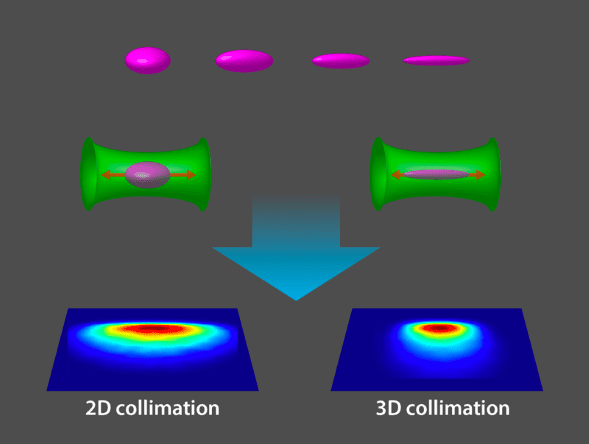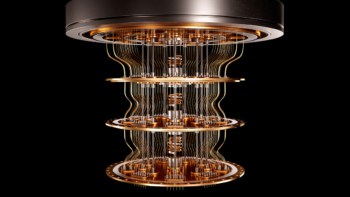
A new way of controlling the expansion of matter in a freely falling Bose–Einstein condensate (BEC) has produced the coldest effective temperature ever measured: 38 pK (10–12 K) above absolute zero. The method, which allowed researchers in Germany and France to image the condensate’s evolution for more than two seconds, opens the door to enhanced measurements of the gravitational constant g and photon recoil, and could even offer an alternative means of detecting gravitational waves.
BECs are clusters of particles in the same quantum ground state. Since they were first created experimentally in 1995, they have become a testbed for research on the quantum nature of matter. One example is matter–wave interferometry, which is a type of interferometer that uses the wave character of atoms. When this is done with free-falling BECs, the resulting interference pattern will depend partly on gravitational effects, making such experiments sensitive tests of fundamental physical processes. However, when a BEC is released from the magnetic trap in which it is created, repulsive interactions between its constituent particles quickly get converted into kinetic energy. This causes the BEC to expand until it becomes too dilute to detect via standard absorption imaging, in which a laser beam is sent through the condensate and a camera measures how much light the particles absorbed.
Because the interferometer’s resolution increases with the square of the free-fall time, limiting the condensate’s expansion is crucial. To do this, physicists use magnetic, optical or electrostatic forces to focus the condensate, similar to the way that lenses focus light. These so-called matter–wave lensing methods can cool the BEC’s effective temperature to as low as 50 pK. However, they only affect the temperature along the condensate’s radii, not in the axial direction of its fall. Hence, even with matter–wave lensing, a BEC in free-fall still expands rapidly.
3D matter-wave-lensing
The new method, which is described in Physical Review Letters, addresses this shortcoming by changing the magnetic field used to trap the condensate in a way that causes its shape to oscillate, transforming it from a ball into a thin ellipse. The condensate then enters free-fall when its axial dimension reaches its thinnest point, which keeps its axial expansion rate as low as possible. Magnetic lensing further controls the condensate’s expansion in the radial directions.
To test their technique, researchers led by Ernst Rasel of Leibniz University Hannover used the 110-metre drop tower in Bremen, Germany. The team began by creating a BEC from a cloud of about 100,000 rubidium atoms. These atoms then underwent a 4.74-second free fall, during which absorption images were taken at various points. When the team imaged their free-falling BEC without any matter-wave-lensing techniques, they found that the condensate degraded within 160 ms of release. By applying their technique, they achieved a record-low effective temperature of 38 pK and imaged the BEC for more than 2 seconds. “Our methods enable new experiments or greatly improve existing ones,” says Ernst Rasel, who led the research at IQO.
“A significant step for atom interferometry”
The team say that more complex magnetic lens configurations could reduce some limitations of the current setup, bringing about even tighter control over the BEC’s expansion. Lowering the number of atoms inside the BEC might also lower the expansion rate, reducing the effective temperature to as low as 14 pK. However, it could also reduce the total imaging time as a smaller BEC would more rapidly become too dilute to image.

Rocket carries Bose–Einstein condensate into space
Florian Schreck, a physicist at the University of Amsterdam in the Netherlands who was not involved in the research, calls the new technique “a significant step for atom interferometry with BECs in situations that allow long free-fall time (e.g. in space or in a drop tower)”. Compared to previous methods, Schreck notes that IQO team’s technique reduces the internal kinetic energy of the gas in all three dimensions, and its simplicity means that it should find wide adoption in rubidium BEC atom interferometry. Translating such a scheme to strontium would, he adds, be “especially interesting”, as strontium is the species of choice for plans to use atom interferometers to detect gravitational waves space.
In the medium term, Rasel and his colleagues plan to demonstrate even longer interferometry times using the Bremen drop tower’s catapult system, after simulations showed that the total imaging time with their technique could be more than 17 seconds. In the future, they also hope to employ their method in the Bose-Einstein Condensate and Cold Atom Laboratory (BECCAL), a planned space-based facility.



